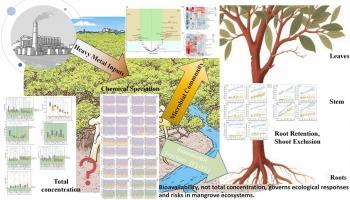红树林湿地重金属的命运:沉积物-微生物-植物相互作用和分数控制的综合见解
IF 11.3
1区 环境科学与生态学
Q1 ENGINEERING, ENVIRONMENTAL
引用次数: 0
摘要
为了揭示红树林生态系统中重金属(HMs)复杂的生物地球化学命运,本研究揭示了其总分布的环境驱动因素及其生态生物有效性。采用比较偏最小二乘路径模型(PLS-PM)对北部湾不同人为压力梯度下的四个红树林区域进行了研究。这些模型揭示了一个关键的分歧:虽然沉积物的物理结构是控制有机质总分布的主要因素,但它们的生物利用度更复杂地受到沉积物化学(盐度)和养分循环(N, P)的综合影响。这部分控制的生物利用度,反过来,是一个明显更好的预测生物反应。在植物积累方面,虽然根系吸收与沉积物生物利用度相关,但地上组织的金属负荷在很大程度上与沉积物条件脱钩,这对仅基于沉积物数据的风险评估范式提出了挑战。对于微生物群落来说,它们的结构与金属生物利用度的关系比总浓度的关系更强,这些生物利用度似乎对关键的分类类群施加了选择压力。该研究表明,以分数为中心的方法将分布驱动因素与生物利用度驱动因素分离开来,对于从机制上理解和准确管理沿海湿地的HMs风险至关重要。本文章由计算机程序翻译,如有差异,请以英文原文为准。

Heavy Metals Fate in Mangrove Wetlands: Integrated Insights into Sediment-Microbe-Plant Interactions and Fraction Control
To unravel the complex biogeochemical fate of heavy metals (HMs) in mangrove ecosystems, this study disentangled the environmental drivers of their total distribution versus their ecological bioavailability. We employed a comparative Partial Least Squares Path Modeling (PLS-PM) approach across four mangrove areas under a distinct anthropogenic pressure gradient in the Beibu Gulf. The models revealed a critical divergence: while sediment physical structure was the primary factor controlling the total distribution of HMs, their bioavailability was more intricately governed by a combination of sediment chemistry (salinity) and nutrient cycling (N, P). This fraction-controlled bioavailability, in turn, was a significantly better predictor of biological responses. For phytoaccumulation, while root uptake correlated with sediment bioavailability, the metal loads in aboveground tissues were largely decoupled from sediment conditions, challenging risk assessment paradigms based solely on sediment data. For microbial communities, their structure was more strongly associated with metal bioavailability than total concentrations, with these bioavailable fractions appearing to exert selective pressure on key taxonomic groups. This study demonstrates that a fraction-centric approach, which separates the drivers of distribution from those of bioavailability, is essential for mechanistically understanding and accurately managing HMs risks in coastal wetlands.
求助全文
通过发布文献求助,成功后即可免费获取论文全文。
去求助
来源期刊

Journal of Hazardous Materials
工程技术-工程:环境
CiteScore
25.40
自引率
5.90%
发文量
3059
审稿时长
58 days
期刊介绍:
The Journal of Hazardous Materials serves as a global platform for promoting cutting-edge research in the field of Environmental Science and Engineering. Our publication features a wide range of articles, including full-length research papers, review articles, and perspectives, with the aim of enhancing our understanding of the dangers and risks associated with various materials concerning public health and the environment. It is important to note that the term "environmental contaminants" refers specifically to substances that pose hazardous effects through contamination, while excluding those that do not have such impacts on the environment or human health. Moreover, we emphasize the distinction between wastes and hazardous materials in order to provide further clarity on the scope of the journal. We have a keen interest in exploring specific compounds and microbial agents that have adverse effects on the environment.
 求助内容:
求助内容: 应助结果提醒方式:
应助结果提醒方式:


